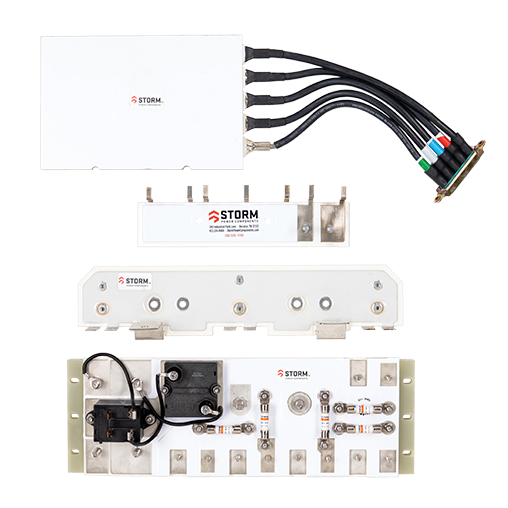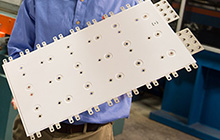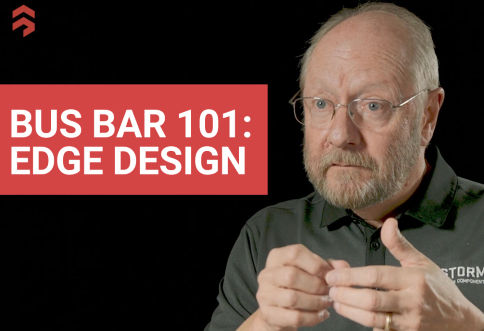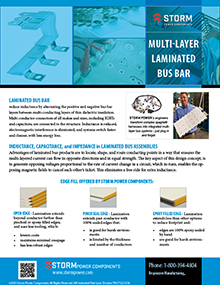
Laminated bus bar - Multiconductor
What is a Multiconductor Laminated bus bar?
Laminated bus bar is the end result of multiple layers of conductive metal (copper or aluminum) separated by paper-thin layers of dielectric material, all of which are then heated and compressed into an integrated component. This assembly provides a number of performance advantages over single layer bus bar and cable conductors.

Bus Bar Lamination Offers More Efficient Multiconductor Power Conversion
Lamination Advantages~
Reliability

Cable harnass before
One of the most common issues with traditional bus bar, cable and wire harnesses is installation error. Traditional bus bar involves a complex web of cables and interconnected parts that are time consuming to assemble. These components are often subjected to operating environments with significant heat and vibration. Unforeseen external factors often cause vibration failure at the assembly points. Laminated bus bar, however, is all pre-assembled in a compact structure. All internal components are fused together during the lamination process, significantly reducing the risk of vibration failure. Furthermore, Storm subjects each laminated bus bar to rigid testing procedures: a HiPot test confirms a part’s ability to perform under unexpected high-voltage, and a Partial Discharge test (when specified in higher voltage systems) validates the long-term efficiency and leakage parameters of a part. These tests ensure that each assembly meets performance and practical life expectations.
Reduced Heat
A laminated bus bar is able to reduce the overall heat in a number of ways. The first advantage is the compact nature of its construction. More efficient use of space in an operating cabinet means improved airflow. In addition to this space efficiency, laminated bus bar is also able to reduce the amount of excess heat in the design stage by designing in the precise amount of conductive materials needed to carry power. Finally, for specific applications, a laminated bus bar design can include a component called a “chill plate” or heatsink. This could be an aluminum layer within the laminated bus bar design with small channels which allow for coolant to be pumped directly through the bus bar.
Low Inductance

Cable harnass after
As mentioned above, a laminated bus bar is constructed of multiple layers of conductive material stacked together. Not only is this structure extremely compact, but the arrangement of the conductive material creates an electro-physical advantage. When power is transferred through conductive material, an electromagnetic field is created. This effect is called inductance. Stray inductance can interfere with nearby electronics, create excess heat, and even cause system failure if not properly addressed.
However, by layering alternatingly charged conductors, separated only by a thin dielectric insulating material (usually around 5 to 10 mils), laminated bus bars utilize the concept of mutual inductance cancellation. Essentially, the overlapping electromagnetic fields cancel each other out. This mutual cancellation not only dramatically reduces stray inductance, but also boosts the overall efficiency of the conductor system. Because of this inherent physical advantage, laminated bus bars are often the best choice for highly-sensitive, critical power systems.
“Clean” Power, Power Conservation, and Future Applications
As electronics and their applications have advanced over the past decades, the power supply for these technologies are advancing too. Our dependency on high-performance computer systems, such as those in electric vehicles and other military and commercial critical systems, has spurred demand for new levels of intelligent and reliable power supplies. For example, in today’s fast switching power supplies used in highly sensitive electronics, IGBTs (Insulated-Gate Bipolar Transistor) have replaced slower, more cumbersome electronics. However, the IGBT requires a low inductance power circuit for optimal performance. As mentioned previously, laminated bus bar is a perfect low-inductance power delivery solution.
Furthermore, solar energy and wind power systems demand the most efficient means of power distribution and energy management. Loss of energy within any system is an issue, as that leakage usually escapes in the form of excess heat. However, the solar and wind power industries are literally selling energy, so any leakage directly affects the bottom line. Unfortunately, it’s not as simple as just connecting the wind turbine directly to the electrical grid. The raw power generated by the wind turbine not only needs to be inverted from DC to AC, but the power supply needs to be scrubbed to be useful. Again, the combination of IGBTs and laminated bus bar provides much needed efficiency to this rapid-growth industry.
Inductance, Capacitance, and Impedance in Laminated Bus Grounding Assemblies
Engineers are tasked to design a lamination that locates, shapes, and routes conducting points in ways to ensure that the multi-layered current can flow in opposite directions and in equal strength. The key aspect of this design is to generate opposing voltages proportional to the rate of current change in a circuit, which in turn enables the opposing magnetic fields to cancel each other's ticket. This eliminates a free ride for extra inductance.
Selecting the Best Geometries & Insulation Materials
With guidance from our Lamination Center team, designers and engineers can be confident that they will make the right choice of insulating material and conductor (bare or plated copper) thickness. You’ll be able to explore design considerations from material to edge seals.
Edge Fills We Offer:
- Open Edge
- Pinch Seal
- Epoxy Filled
Whether the design calls for an open edge, pinch seal, epoxy fill, or a combination of laminated bus bar edge geometries, we’ve got you covered. We’ll help you determine the component that is the best value, while balancing your product’s environmental and space demands. Although bus laminations have been around for almost two decades, newer, advanced insulating materials like Kapton and Teonex work in combination with improved design and fabrication techniques to utilize electric energy more efficiently, and save time and money.
Selection of the proper internal dielectric insulations can depend on capacitance, inductance, voltage potentials, and operating environment. We have a variety of materials in-stock and ready for production. We also have UL-certified materials, and can assist you in the creation of a custom product bulletin.
| Insulation Materials Table | Use Temp. Cº | Constant | Strength | Rating |
|---|---|---|---|---|
| ASTM D150 | ASTM D149 (Volts per mil) | |||
| Epoxy Glass (FR4) Superior mechanical and dimensional stability |
140 | 4.3 | 1250 | UL 94 V-O |
| Mylar (PET) Cost-effective, tear-, chemical-, and moisture-resistant |
105 | 3.3 | 7500 | UL 94 VTM-0 |
| Tedlar (PVF) Chemical/solvent resistant, good mechanical properties |
105 | 11.0 | 3500 | UL 94 HB |
| Teonex (PEN) Higher deflective strength and continuous-use temperature |
140 | 3.4 | 5000 | UL 94 VTM-0 |
| Nomex® Flame-resistant, durable |
220 | 1.6 | 430-845 | UL 94 V-0 |
| Kapton® (Polyimide) High temperature rating and range stability |
400 | 3.7 | 5000 | UL 94 VTM-0 |
| Epoxy Powder Coating Flame- and moisture-resistant, ideal for multiple shapes |
130 | 4.0 | 800 | UL 94 V-0 |

